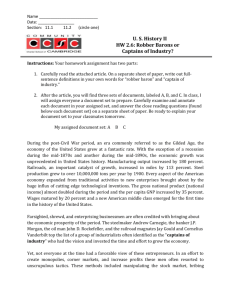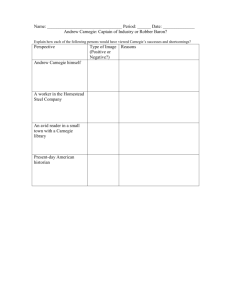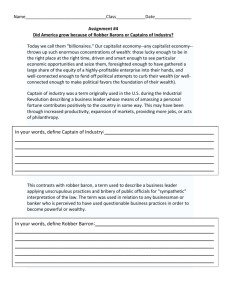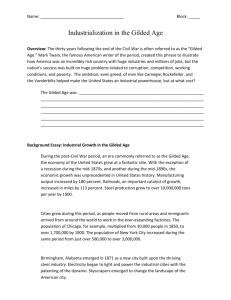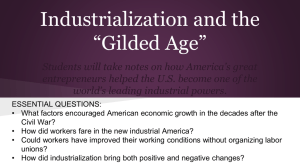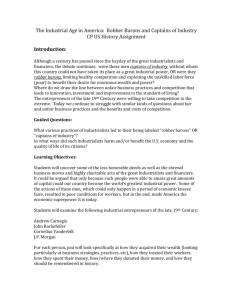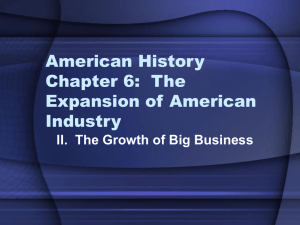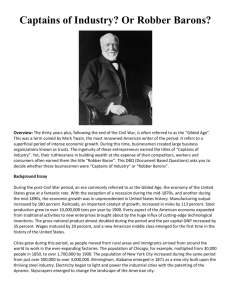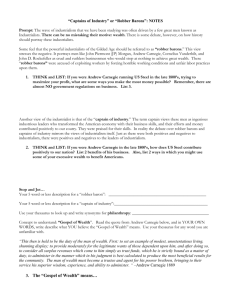Robber Barons DBQ
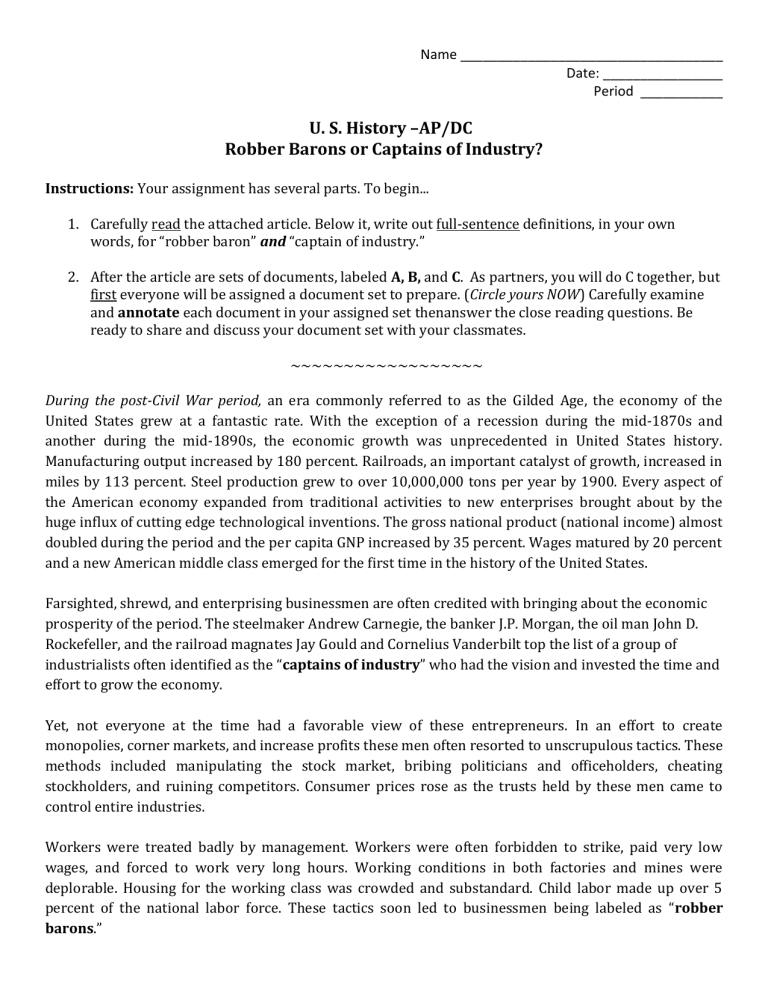
Name ___________________________________
Date: ________________
Period ___________
U. S. History –AP/DC
Robber Barons or Captains of Industry?
Instructions: Your assignment has several parts. To begin...
1.
Carefully read the attached article. Below it, write out full-sentence definitions, in your own words, for “robber baron” and “captain of industry.”
2.
After the article are sets of documents, labeled A, B, and C . As partners, you will do C together, but first everyone will be assigned a document set to prepare. ( Circle yours NOW ) Carefully examine and annotate each document in your assigned set thenanswer the close reading questions. Be ready to share and discuss your document set with your classmates.
~~~~~~~~~~~~~~~~~~
During the post-Civil War period, an era commonly referred to as the Gilded Age, the economy of the
United States grew at a fantastic rate. With the exception of a recession during the mid-1870s and another during the mid-1890s, the economic growth was unprecedented in United States history.
Manufacturing output increased by 180 percent. Railroads, an important catalyst of growth, increased in miles by 113 percent. Steel production grew to over 10,000,000 tons per year by 1900. Every aspect of the American economy expanded from traditional activities to new enterprises brought about by the huge influx of cutting edge technological inventions. The gross national product (national income) almost doubled during the period and the per capita GNP increased by 35 percent. Wages matured by 20 percent and a new American middle class emerged for the first time in the history of the United States.
Farsighted, shrewd, and enterprising businessmen are often credited with bringing about the economic prosperity of the period. The steelmaker Andrew Carnegie, the banker J.P. Morgan, the oil man John D.
Rockefeller, and the railroad magnates Jay Gould and Cornelius Vanderbilt top the list of a group of industrialists often identified as the “ captains of industry ” who had the vision and invested the time and effort to grow the economy.
Yet, not everyone at the time had a favorable view of these entrepreneurs. In an effort to create monopolies, corner markets, and increase profits these men often resorted to unscrupulous tactics. These methods included manipulating the stock market, bribing politicians and officeholders, cheating stockholders, and ruining competitors. Consumer prices rose as the trusts held by these men came to control entire industries.
Workers were treated badly by management. Workers were often forbidden to strike, paid very low wages, and forced to work very long hours. Working conditions in both factories and mines were deplorable. Housing for the working class was crowded and substandard. Child labor made up over 5 percent of the national labor force. These tactics soon led to businessmen being labeled as “ robber barons .”
By the early twentieth century, the richest 9 percent of Americans controlled 75 percent of the national wealth. The number of millionaires increased from 300 to 4,000. Yet, working families were forced to rely on two, three, and sometimes more, incomes to make ends meet. To the poor, the working class, reformers, and consumers, the Gilded Age was not golden.
Still, the businessmen of the period felt justified in their actions as the United States became the world’s leading industrial power with the U.S. producing as much as Germany, Britain, and France combined. Yet their ruthlessness in building wealth at the expense of their competitors could not be ignored. Were these businessmen truly “Captains of Industry” or “Robber Barons?”
ROBBER BARON--
CAPTAIN OF INDUSTRY
Document Set A: Andrew Carnegie
Document A-1. Source: Andrew Carnegie, Wealth and Its Uses (1907)
“It will be a great mistake for the community to shoot the millionaires, for they are the bees that make the most honey, and contribute most to the hive even after they have gorged themselves full.”
“While the law [of competition] may be sometimes hard for the individual, it is best for the race, because it ensures the survival of the fittest in every department. We accept and welcome, therefore, as conditions to which we must accommodate ourselves, great inequality of environment, the concentration of business in the hands of the few, and the law of competition between these as being not only beneficial, but essential for the future progress of the race.”
Document A-2. Source: Andrew Carnegie, “Wealth”, North American Review (1889)
“This, then, is held to be the duty of the man of wealth: First, to set an example of modest, unostentatious living, shunning display or extravagance;…and after doing so, to consider all surplus profits which come to him simply as trust funds, which he is called upon to administer…to produce the most beneficial results for the community—the man of wealth thus becomes the trustee and agent for his poorer brethren, bringing to their service his superior wisdom, experience and ability to administer [the wealth] for them far better than they would or could do for themselves.”
Close-Reading Questions
1.
In the first quote, what does Carnegie mean by “contribute most to the hive”?
2.
In the second quote, what does Carnegie mean by “survival of the fittest”? What concept is
Carnegie promoting with this quote?
3.
What does the man of wealth have that “his poorer brethren” do not (besides money)? What does
Carnegie argue is the role of the millionaire in relation to the community?
Document Set B: “The Protectors of our Industries,” Puck , 1883
Close-Reading Questions
1. In the cartoon above, who do the men at the top of the image represent? What are they sitting on?
2. What do the men at the bottom of the image represent?
What are they trying to do?
3. What is the message that the cartoonist is trying to make with this cartoon?
Document Set C: Historical Interpretations
Document C-1. Historian A, 1927
“The industrialist robber barons of the late 19 th century were predatory and materialistic; their bloated corporations were threats to the humane and democratic values that made America great. Business tycoons turned modern America, with its standardized life and material culture, into a place in which
Jefferson and Lincoln would be strangers. The giants of industry were primitive souls, ruthless, predatory, capable; single-minded men, rogues, and rascals often, but never feeble.”
Document C-2. Historian B, 1953
“Much of the blame heaped on the captains of industry in the late 19 th century is unwarranted. Although people like Rockefeller used methods that were ethically questionable, the kind of monopolistic control that they exercised was a natural response to the cutthroat competition of the period. The captains of industry like Rockefeller were innovators, thinkers, planners, and bold entrepreneurs who imposed upon
American industry a more rational and efficient patterns. They also created a model of philanthropy for all to follow.”
Close-Reading Questions
1. What view does Historian A have of Gilded Age entrepreneurs?
How does he describe them?
2. What view does Historian B have of Gilded Age entrepreneurs?
How does he describe them?
3. How might these two scholars have arrived at different conclusions?
Written Assignment – do not start on this until we have discussed it in class!!
Prompt: Were businessmen of the Gilded Age like Carnegie, Rockefeller, Morgan, and Vanderbilt “captains of industry” or “robber barons”?
1.
Thesis statement (that demonstrates all 3 elements of effective thesis statements) Thesis-
Statements
2.
1-2 sentences before thesis providing context for the thesis
3.
2-3 sentences before or after the thesis acknowledging why one might believe the other side
4.
2 paragraphs that support your position with specific , relevant evidence


